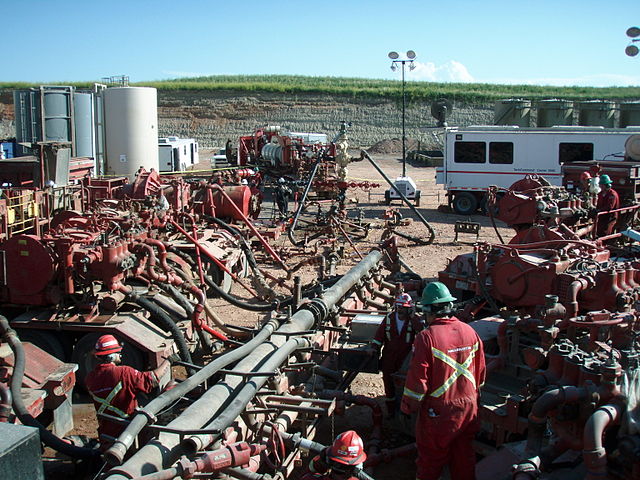
The New American Oil Empire Built on Sand
By F. William Engdahl
11 September 2019
Image credits: Joshua Doubek - Fracking the Bakken keeping American energy independent Usage Rights: This file is licensed under the Creative Commons Attribution-Share Alike 3.0 Unported license with some restrictions.https://bit.ly/2mccE3Q
Over the course of the past decade the United States, following decades of relative stagnation in oil production, has surprised many to become the largest oil producer in the world, exceeding Russia as well as Saudi Arabia. Latest daily production is just above 12.1 million barrels a day. In November 2018 for the first time in decades the US became a net oil exporter. The geopolitical implications to this energy boom in a world where oil determines the growth of entire economies, would appear to be great. Almost all the increase owes to the exploitation of what is called shale oil, unconventional oil found in shale rock formations. The US Department of Energy projects a rise to 8.8 million barrels daily from US shale oil alone, a new record. Now though, we are seeing the first clear signs that the “shale boom” could implode even faster than it rose. The implications for American foreign policy and global geopolitics and economics are significant
.
The ‘Fracking’ Revolution
The idea of extracting oil or natural gas embedded in shale rocks has been known for years. However shale oil, or tight oil as it is known, first became economical with introduction of new horizontal drilling techniques combined with oil prices of $100 a barrel or more. This was about two decades ago.
In hydraulic fracturing or fracking, oil embedded in shale rock thousands of feet down is injected with a high pressure mix of water, lots of it, mixed with chemicals and sand. The de facto sand blasting creates fissures where oil can flow into the oil pipeline. The actual drilling of a shale well is only about 30-40% of the total cost. Up to 55-70% are from completion which includes actual fracking. The independent oil consultancy, Wood Mackenzie, recently estimated that the USA held an impressive 60% of all world shale reserves that are economically viable at oil prices of $60 per barrel or less.
Now it begins to get interesting. The current price for the West Texas Intermediate marker grade of oil is around $58 a barrel, where it has been for months. The price has not shot up as many expected despite the disruptions in Venezuela, in Iran and around the Persian Gulf. This puts shale well production, much of which today is in the Permian basin in West Texas or Bakken in North Dakota, at a delicate point.
When Saudi Arabia and the Arab OPEC producers decided to flood the market in 2014 with cheap oil in order to force the US shale producers into bankruptcy, the results were disastrous for the OPEC countries financially, but new technology advances allowed the major part of US shale oil production to survive at far lower prices. That, combined with a Federal Reserve Zero Interest Rate Policy (ZIRP), made borrowing to produce oil attractive for shale companies. Now, with two years of gradual Fed rate increase policies, shale companies are beginning to show signs of major stress.
Economic Troubles
Little known is the fact that despite all technological advances and economies of scale, the USA shale oil industry as a whole has yet to turn a net profit. At a juncture when world GDP growth begins to look very bleak, whether in China or in the EU or Emerging Markets like Brazil or Argentina or Turkey, US shale companies face a critical juncture.
The year 2018, according to projections of the International Energy Agency was supposed to be the year that the shale industry finally turned a profit. The IEA wrote in early 2018 that “higher prices and operational improvements are putting the US shale sector on track to achieve positive free cash flow in 2018 for the first time ever.” Since it began, until the Saudi price crash, that is from 2000-2014, US shale companies as a whole according to IEA estimates, already generated a cumulative negative free cash flow of more than $200 billion. With glowing predictions for a “new Saudi Arabia, and banks willing to lend to after the 2008 financial crisis, money poured into shale. Companies claimed once infrastructure was in place the profits would soon flow. It didn’t. Despite over two years of rising world oil prices, some 33 US publicly traded shale companies had a combined negative cash flow of $3.9 billion in the first half of 2018.
But with possible war with Iran and the unrest in Venezuela combined with projections of a growing US economy, the US shale industry told their bankers that 2019 would be the year finally of net profit. The reality has been the opposite. Shale company combined capital expenditures for the first Quarter of 2019 alone have exceeded operating cash flow by a whopping $5 billion. And now with oil prices stuck seemingly at $58 and the prospects for economic slowdown, not only abroad but more recently in the USA itself, many bank lenders to the US shale oil bonanza are having second thoughts.
Unconventional means more cost
Unconventional means by definition more costly to produce. Shale, unlike conventional oil reservoirs, deplete far faster than normal oil wells. In many cases a shale well loses 70% of recoverable oil the first year. The Permian Basin has been measured at 22% a year. To justify taking on debt via junk bonds and other lending to continue producing, shale companies went to the best, so-called “sweet spots” and projected the optimistic numbers into the future.
Explaining second quarter 2019 profits, the CEO of one of the most successful companies, Scott Sheffield of Pioneer Natural Resources warned in early August that most of the oil from so-called “sweet spots,” or “tier 1 acreage,” has already been extracted. “Tier 1 acreage is being exhausted at a very quick rate,” Sheffield stated.
To counter faster depletion rates of shale wells, companies have resorted to technical changes in terms of sand, closeness of drilling and other means. As the drilling is forced to go to less ideal areas, one oil industry source likened it to walking up the down escalator, drilling more just to stay even. That costs more per barrel.
Now an alarming new industry report suggests that the shale oil producers, at least in the rich Permian Basin, have been faking their numbers or under-reporting the shale wells completed to make the numbers look better. A detailed report by energy analysts at Kayrros indicates that oil companies in the Permian Basin greatly under-reported the number of shale oil wells completed in 2018. Kayrros estimates that more than 1,100 wells were completed in the Permian Basin but not reported as required by law. That would mean a significant 21% greater number of completed wells to produce the same volume as had been reported. That means the average well is far more expensive per barrel and far less efficient. Kayrros advisory chairman and CEO of Schlumberger, Andrew Gould remarked, “With far more wells contributing to Permian and US oil production than accounted for, current shale oil production is substantially more water- and sand-intensive than is commonly believed.” Kayrros estimates that in 2018 in the Permian Basin alone that actual demand for special grade sand was under-estimated by 9.2 billion pounds and water under-estimated by 12.5 billion gallons. That’s a lot of sand and a lot of water. At some point the companies will be importing sand from the deserts of Arabia at that rate. The environmental costs of shale oil fracking in terms of water, contamination, earthquakes are enormous and need a separate treatment.
To worsen the energy outlook, the spectacular oil production growth rates in the US appear to be stagnating, a worrisome sign given the fact that shale wells deplete annually at anywhere between 20-40% per year or more compared with around 4% for conventional wells. Earlier estimates suggested that the largest US shale region, Permian Basin, would reach its economic peak around 2025 or after.
A recent study of shale production by J. D. Hughes, an oil geologist who has followed the industry closely, suggests that with productivity per well peaking or even in some regions like North Dakota actually declining, oil companies are being forced to pour more money in, drill more just to replace lost output. In 2018, the industry spent $70 billion on drilling 9,975 wells, according to Hughes, with $54 billion going specifically to oil. “Of the $54 billion spent on tight oil plays in 2018, 70% served to offset field declines and 30% to increase production,” Hughes wrote. He added, “production will fall as costs rise. Assuming shale production can grow forever based on ever-improving technology is a mistake—geology will ultimately dictate the costs and quantity of resources that can be recovered.”
Add to this all the huge debts of the shale oil companies are a growing problem. According to the Wall Street Journal some $9 billion worth of debt is set to mature over the second half of 2019 and banks are becoming reluctant to continue financing in a weaker economy. Then a staggering $137 billion in debt matures between 2020 and 2022, debt that was taken on to survive the 2014-15 oil market meltdown. Many producers will likely go down, though giants like ExxonMobil will survive.
If major oil shale regions are already beginning to shows signs of limits at present prices, and if decline rates are about to significantly accelerate over the coming 2-3 years, it will have major implications for US foreign policy as well as the economy. A major factor in the recent actions of Washington in the Middle East and even Venezuela has clearly been driven by a sense that America no longer depends on foreign oil and can take greater geopolitical risks. Oil and the remarkable shale boom were largely behind this impression.
The Trump Administration began in 2017 as one of the most oil-friendly in recent history. Rex Tillerson, CEO of ExxonMobil, was named Secretary of State. Texas oil-friendly Governor Rick Perry headed Energy Department. Others were named who favored expansion of shale oil as a national priority. If this domestic shale oil support suddenly begins to vanish, it will send major new shock waves around the globe at a time when shock waves are coming from every direction. It’s not the end of the Oil Age, but it could soon be the end of the USA shale oil boom, one fueled on mountains of debt, horrendous environmental destruction and wishful thinking. In turn that could trigger a global oil price shock that will turn the economy dramatically down.
F. William Engdahl is strategic risk consultant and lecturer, he holds a degree in politics from Princeton University and is a best-selling author on oil and geopolitics, exclusively for the online magazine “New Eastern Outlook”
